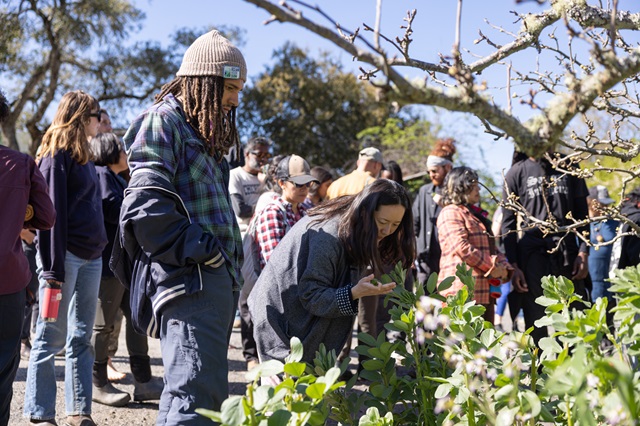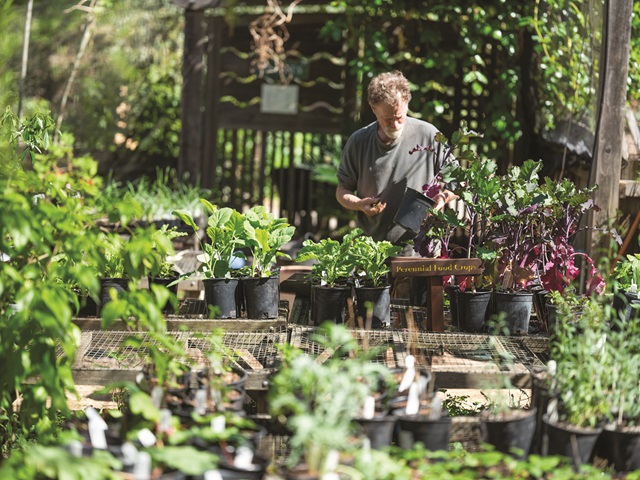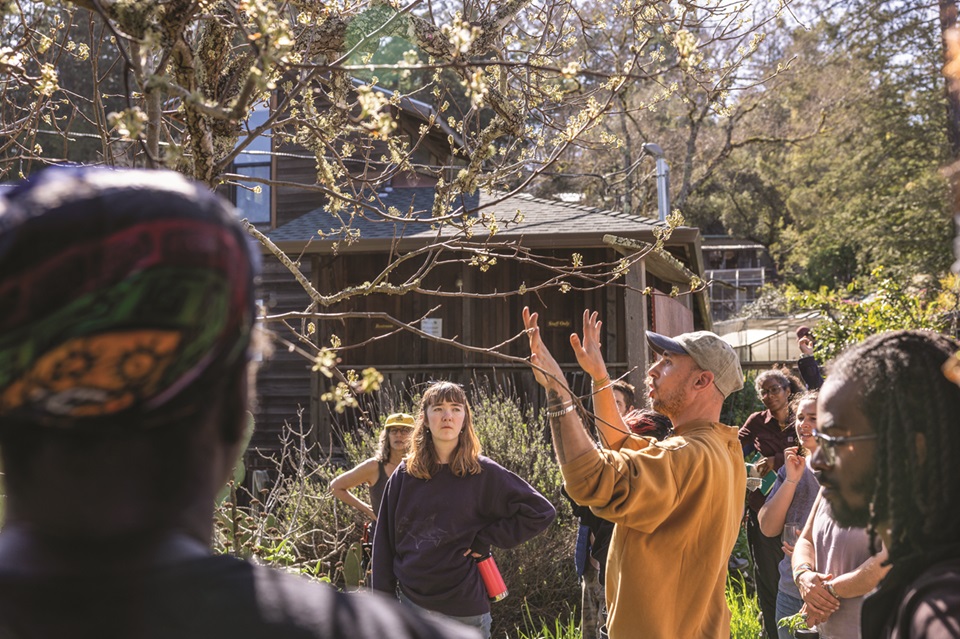Perennial Harvest
The Mother Garden Plant Nursery
PHOTOS BY PAIGE GREEN
The Occidental Arts and Ecology Center (OAEC) has been making legendary salad mix from their deep-rooted, biointensive gardens for decades. But you might not know that back in the 1980s, a Bay Area produce distributor sent a spy to OAEC to discover and replicate the exclusive salad mix recipe. Instead, the spy discovered something that could never be mass-produced: a recipe that wasn’t even a recipe but an ever-changing seasonal field blend, including more than 100 ingredients that evolved and changed, sometimes significantly, from week to week with the shifting seasons.
“That’s where biointensive comes in, and a human-scale garden where you can actually do fine work,” says Doug Gosling, OAEC’s Garden & Nursery program director.
He would know. Gosling has not only been tending the OAEC garden for 40 years now, he’s also a founder of the Mother Garden Plant Nursery at OAEC, now almost two decades old. The nursery, which began as a seasonal plant sale years ago, is now open to the public 10 am – 5 pm on Saturdays and Sundays from April through October.
THE MOTHER GARDEN NURSERY
The 100% Certified Organic plant nursery specializes in open-pollinated perennials, featuring edible landscaping plants, rare and endangered food crops, drought-tolerant ornamentals, and habitat plants, including those for medicinal, culinary, pollinator, soap, fiber, dye, and perfume use.
The Mother Garden Nursery has become something of a destination, with locals in the know arriving every year and patrons from as far away as Los Angeles traveling to find special plants from OAEC’s distinctive collection.
Tasty finds include unique varieties of artichokes, spinach, goji berries, strawberries, prickly pears, tree collards, many types of scented geraniums, tree dahlias, horseradish, stevia, and even tamarillos, also called tree tomatoes.
“This one might be ready,” Gosling says, reaching up and cutting a tree tomato growing near the nursery’s doorway. It’s an orange fruit that looks like a dyed Easter egg hanging from a tree branch. He slices it into pieces and passes it around to eat. The firm, late-winter fruit tastes like a cross between a plum and a melon with a hint of tomato and persimmon.
“You can eat many of the edible plants throughout their whole life cycle, like lettuces.” He continues, “You can eat the leaves going up the stems, you can eat the buds of the flowers. It’s how our (salad) mix became so diverse, it was almost an expression, a snapshot of the garden on any given day,” he smiles. “It means that the salad mix is different every week, so it can’t be reproduced.”
BIOREGIONAL GARDENING
For the backyard gardener, the delicious possibilities are endless, especially with the new trend in perennial vegetables, which don’t have to be planted each spring. From hot peppers to Andean tubers like mashua and oca, these crops continue to grow from year to year. However, finding these perennial plant starts can be challenging. Luckily, the OAEC nursery has you covered with at least 300 varieties to create a custom edible landscape.
“People come here because they can’t find these things anywhere else,” says Olivia Rathbone, OAEC communications director and lead author of the award-winning Occidental Arts & Ecology Center Cookbook (Chelsea Green Publishing, 2015). “Doug typically propagates plants that you can’t just go buy anywhere.”
Each plant variety has been chosen for its suitability for the bioregion. And because all selections are thoroughly tested over years in their onsite gardens, their ability to thrive is ensured. Additionally, not just the plants but many of the seeds are even from the OAEC gardens.
“Probably about half of what we sow are from seeds that we grew here. A lot of the plants have been here for some time, so people can actually buy plants that are already at home,” says Gosling.
Besides food crop plants, a visitor may find difficult-to-source offerings like Tea Tree; Jojoba; dye plants including Blue Wild Indigo, Weld, and Madder; fiber plants like Blue Flax; and even the South African Spilanthes, commonly called “toothache plant” that numbs your tongue when you nibble its leaves. Visitors will also find perfume plants like orris—its root is one of the original perfume scent ingredients—and decorative and edible flowering maples, also known as Abutilon.
“Ooh, that’s a pretty one,” Gosling enthuses, picking a gorgeous red and white flower off a flowering maple in the greenhouse. “Look at that. Imagine finding something like that in a salad!” he notes, eating it.
DECADES OF EXPERIENCE
It’s a year of anniversaries for OAEC. The OAEC Mother Garden is 50 years old this year. OAEC itself, now 30 years old, began in 1994 when a group of friends, brought together by shared involvement in activist and cultural endeavors, collaborated and pooled their resources to create an intentional community there.
Gosling has lived on the land for 40 years, and during this time, he has tended the garden and cultivated the meticulous and unusual community of plants dedicated to preserving biodiversity.
“We were certified organic in 1980. And something that’s impressive is that this spot has been continuously gardened for 50 years,” he says of OAEC’s Mother Garden. “It’s amazing. And it’s all hand tilled. There’s no machinery except for lawnmowers. The beauty of that is that it means that the techniques that we use here can be exported anywhere.”
The exportation of ideas is key at OAEC, which leverages its home base, extends its initiatives beyond its borders, and actively engages with broader communities to implement impactful solutions. Indeed, part of OAEC’s mission is to serve as a demonstration and education site. They’ve graduated more than 1,300 students in permaculture design in the longest continuously running permaculture certification program in North America, and their WATER Institute Program promotes understanding of the importance of healthy watersheds.
Customers who visit the nursery will also find native plants to add to their own healthy and sustainable landscapes, including many varieties of sage and multiple native California yarrows from different local areas, including the Sonoma Coast.
“We say that we have daughter gardens elsewhere,” Gosling adds, “because there are some people who say, ‘Just about everything in my garden came from your nursery!’”
While seeding new gardens in the area, OAEC is also helping to create regenerative landscapes. “Our plant collection and seed bank emphasize food crops of special genetic, cultural, and historic importance that are appropriate to our bioregion,” explains Rathbone. “The Mother Garden Biodiversity Program also hosts three of the biggest seed exchanges (really seed giveaways) in California as an act of resistance against the commodification of seeds by corporations.”
For his part, Gosling’s odyssey into the world of locally grown plant biodiversity began right here in this place decades ago, when he first began working in the then ten-year-old garden.
“I met some farmers who were growing chicory, and they hooked me,“ he shares. “I thought, ‘The world is full of interesting foods that we don’t know about here,’ so I started collecting plants and seed saving, focusing on food crops and medicinal herbs, culinary herbs, some pollinator plants, but mostly food crops.”
He stops and indicates toward the newly cultivated, rich dark soil of the south garden. “If we could name one legacy of this garden, it’s the soil. It isn’t even so much the plants—even though the plants are important—the soil is what’s been built over the years,” he says. “A lot of people think that soil is dirty, but it’s alive and it feels good. And it’s infinitely complex. When the soil is healthy, the plants are healthy. You could put anything in there! And then we’re healthy by eating them.”
It’s a human-scale, life-centered system of gardening and living that just can’t be mass-produced but can grow exponentially in landscapes everywhere.
oaec.org | 707-874-9591
Mother Garden Nursery at Occidental Arts and Ecology Center (OAEC)
15290 Coleman Valley Road (upper driveway)
Occidental
Open 10 am-5 pm, Saturdays and Sundays
April through October





